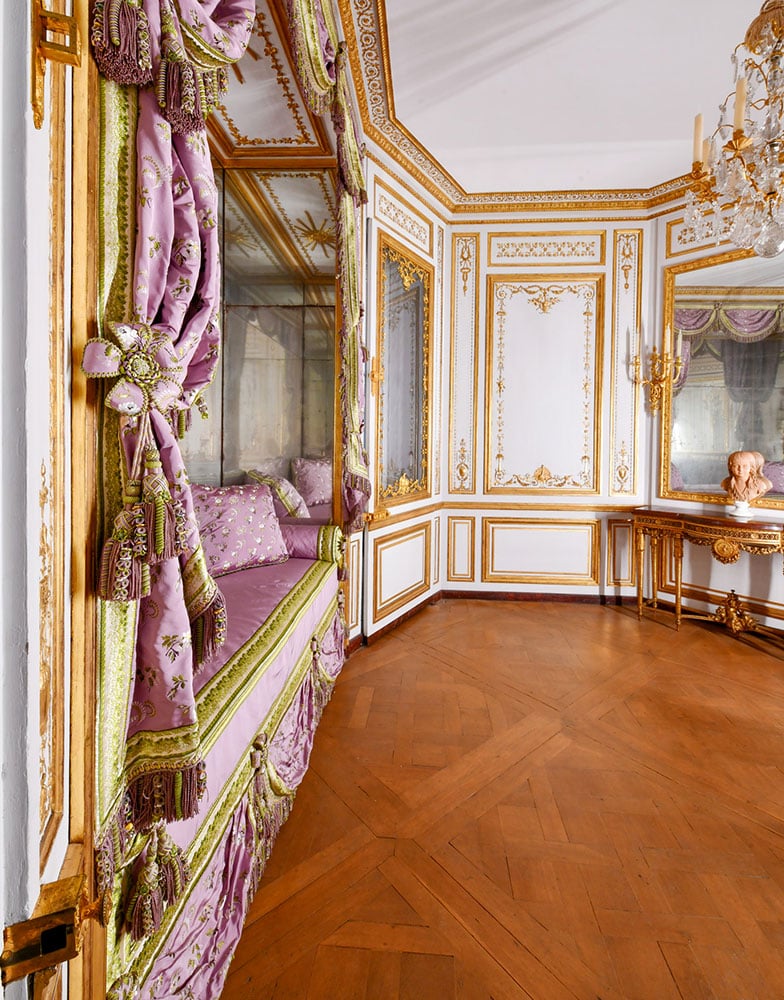Shortly after her arrival in Versailles in 1770 to marry the future King of France (at the age of 14), and especially on acceding to the throne in 1774, Marie-Antoinette set out to claim the apartment of the Palace of Versailles as his personal domain, complete with several hidden chambers accessed through a secret door in his chamber. The young queen was quick to adorn her new sanctuary with sumptuous furnishings worthy of her royal stature.
As part of the palace’s 400th anniversary, visitors can now marvel at the lavish rooms that once belonged to the iconic monarch, the final stage of an extensive and meticulous five-year renovation. The private quarters have just been unveiled to the public, offering a glimpse of the sacred places where Marie-Antoinette spent intimate moments, playing with her children or entertaining close friends. (Such scenes were memorably imagined by director Sofia Coppola in her 2006 biopic of the Queen; however, filming took place on a sound stage in Paris.)

day bed Bedroom. Photo: T.Garnier. Courtesy of the Palace of Versailles.
Due to a lack of historical records, recreating these pieces exactly as they existed has been a major project. The researchers consulted plans, orders from suppliers and various documents from the time to establish what the parts could have looked like. Archivists have also searched for evidence of the Queen’s hand-selected fabrics, including scraps of fabric discovered during modern renovations of sofas and chairs.
Each piece tells a different story. The Meridian room (named after a divan housed in a mirrored alcove) was dedicated to the birth of the royal couple’s first son. The decor of this room currently presents a faithful reproduction of the original textile decoration in shades of lilac, among the most precious in the palace.
The adjacent library, also restored, features tricolor gilding, doors concealed by false book covers, and an ingenious rack and pinion system that allowed for adjustable-height shelves. The Queen also transformed the billiard room – a popular game at court – into living quarters for maids and servants.

Library of Marie Antoinette. Photo: T.Garnier. Courtesy of the Palace of Versailles.
The Golden Room owes its name to Marie-Antoinette’s fascination with ancient Egypt and Rome. She added woodwork in 1784, made by her architect, Richard MiqueRichard MicRichard MicRichard Micwho came up with the more contemporary look using styles that had come into fashion from the recent discovery of the remains of Pompeii and Herculaneum. Throughout this particular room, the walls are covered with canvas of jouy representing pineapples, a symbol of wealth at the time, a motif reproduced by the modern house of Pierre Frey.
Spanning two floors and overlooking a serene inner courtyard, the Queen’s lavish private apartments reveal her high standards, not to mention an appreciation of her rank. Its demanding nature and endless renovations have drawn the ire of Ange Jacques Gabriel, the king’s architect whose structures include the Place de la Concorde, the Ecole Militaire, as well as the Petit Trianon and the opera house on the grounds. From the palace.
While the events of 1789 saw the queen swiftly exit the palace (these rooms are believed to be the first she hid in during the march on Versailles), public hostility towards the sovereign has since waned. Today, visitors have the extraordinary opportunity to enter the private world of Marie Antoinette and see how the young queen lived out the last days of the Ancien Régime until the French Revolution.
More trending stories:
A Norwegian father hiking with his family discovered a rock face covered in Bronze Age paintings
Gnarled old tooth found in museum cabinet may hold key to understanding ancient hippo relative
Follow Artnet News on Facebook:
Want to stay one step ahead of the art world? Subscribe to our newsletter to receive breaking news, revealing interviews and incisive reviews that move the conversation forward.
